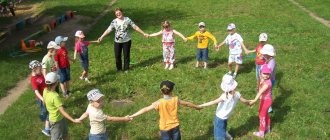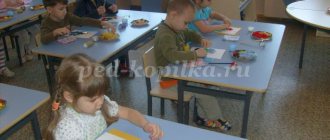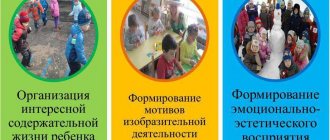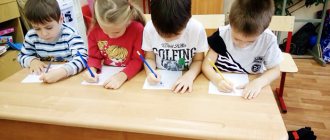Rhythmics for children: lesson in kindergarten
Rhythmics (rhythmic gymnastics) is a system of musical and rhythmic education, the purpose of which is to develop a sense of rhythm and coordination. Rhythmics is also called classes for children (usually preschool age), in which children learn to move to musical accompaniment, control their body, and develop attention and memory.
Rhythm for children is accompanied by fun, rhythmic music, so they perceive the classes positively, which, in turn, allows them to better assimilate the material.
A little history
Rhythmics, as a teaching method, was created at the beginning of the 20th century by a professor at the Geneva Conservatory, Emile Jacques-Dalcroze, who noticed that even the most careless students began to perceive and remember the rhythmic structure of music as soon as they began to move to the music. These observations laid the foundation for a system later called “rhythmic gymnastics.”
What does rhythm give?
In rhythmic classes, the child develops in many ways, acquiring a number of skills and abilities:
- The child’s physical fitness improves and coordination of movements is developed.
- the child learns the simplest dance movements, masters concepts such as tempo, rhythm, as well as the genre and nature of music
- the baby learns to adequately express and control his emotions, creative activity develops
- Rhythm in kindergarten is a good preparation for further music, dance, and sports classes.
- Rhythmic exercises provide excellent “peaceful” relaxation for hyperactive children
- rhythm for children helps to relax, teaches them to move freely, creates a feeling of joy
- Rhythmic lessons instill a love of music and develop a child’s musical taste
Differences between rhythmics and physical education or aerobics
There is certainly a lot in common between rhythmic gymnastics and regular physical education or aerobics - physical exercises in both are performed to music in a certain rhythm. But at the same time, different goals are pursued. Rhythm does not prioritize physical development, performance technique is not a priority, although this is also important.
The emphasis in rhythmic gymnastics is on developing coordination, the ability to listen and hear music, feel your body and control it freely, and, of course, develop a sense of rhythm.
When should I start exercising?
It is believed that it is optimal to start doing rhythmic gymnastics at 3-4 years old. By this age, coordination of movements is already quite developed. Rhythmics in kindergarten is usually carried out starting from the 2nd junior group. But early development centers also practice earlier starts.
After only a year, having barely learned to walk, toddlers are able to learn basic movements and perform them to music. The baby will not learn much, but he will acquire useful skills that will greatly facilitate his further general and musical development and learning.
Structure of a rhythm lesson
Rhythmic exercises include moving exercises that require sufficient space. Rhythm in kindergarten is carried out in a physical education or music room, usually accompanied by a piano (the use of soundtracks of children's songs and modern dance tunes will also be beneficial and diversify the lesson).
Children quickly get tired of monotonous activities, so the lesson is based on alternating small 5-10 minute blocks. First, physical warm-up is required (walking and running variations, simple exercises). Then comes the “main” active part, which requires maximum tension (both physical and intellectual). After which the children need rest - quiet exercises, preferably sitting on chairs. You can arrange complete “relaxation” with soothing music.
Next is the active part again, but on familiar material. At the end of the lesson, it’s good to have an outdoor game or start a mini-disco. Naturally, at all stages, including relaxation, material is used that is suitable for achieving the goals of rhythmic gymnastics.
Author – Sue Mac
For children
Children's rhythmic gymnastics looks a little different. To hold the attention of children and arouse their interest in activities, it is not enough just to have exciting music. It is necessary to arrange all exercises in the form of a game using props.
And it is recommended to significantly reduce the duration of the complex without a clear division into warm-up, main part and conclusion:
- One of the favorite exercises for kids is “dwarf walking”. To perform it, the child is asked to take steps on slightly bent legs. At the same time, he places his feet with his toes outward and then inward.
- In the “dance of the gnomes,” the baby needs to bend his legs slightly and keep his hands on his belt. From this position you need to bend over with synchronized head nods.
- In the “Snow White Erases” exercise, the child performs double and single swings to the sides. With the first, he should pretend to be rubbing the laundry with his fists, with the last, he should rinse it.
- The next element is called "the dwarves welcome Snow White." During this exercise, the baby needs to bend his legs and keep his back straight. First, clap your thighs, then raise your arms up and jump.
- To implement the baby seal exercise, the baby needs to lie on his stomach, bend his arms at the elbows, and at the same time raise his head, shoulders and body up. Then “slide” your feet along the mat.
- And the complex of children's rhythmic gymnastics ends with a fun run with raising the knees to the chest and jumping on one and two legs.
Warm-up
All parts of the body should be warmed up, starting with the head:
- Take your starting position standing. Place your feet shoulder-width apart, hands on your waist. In an active rhythm, start rotating your head, first clockwise, then counterclockwise.
- Without changing your position or slowing down, make circular movements with your shoulders back and forth.
- Stretch your hands. Do the swings, shake them. Stretch your hands by clasping your palms and making chaotic rotations and wave-like movements.
- Now let's move on to the lower back. Perform half-bends forward and backward, left and right. In this case, your hands can be kept at the waist or extended in the direction of the inclination.
- Rotate your hips in circles and figure eights and move on to swinging your legs. It doesn't matter what kind of stretch you have. The main thing is not to fall out of the musical rhythm. This element can be replaced with deep lunges, which also provide warming and stretching of the hip muscles and ligaments.
- And the final step will be warming up the feet. To do this, lift one leg onto your toes and twist it. Do the same with the other leg.
As you can see, the preparatory exercises largely coincide with general developmental exercises. However, in rhythmic gymnastics there are four types of walking, which should also be performed at the warm-up stage and in breaks between dynamic exercises:
- “Step-touch” (or additional step with touch). Adhering to the musical rhythm, it can be performed with turns, jumps and arbitrary movements.
- "March". Or steps in place with the knee raised at waist level.
- "Cross step". Or a cross step with turns and arbitrary movements.
- "Green Wine." Or a cross step moving first to the right, then to the left.
It is recommended to count by four or eight units.
At this point the preparatory part can be considered complete. Now you should move on to the main stage of the lesson.



